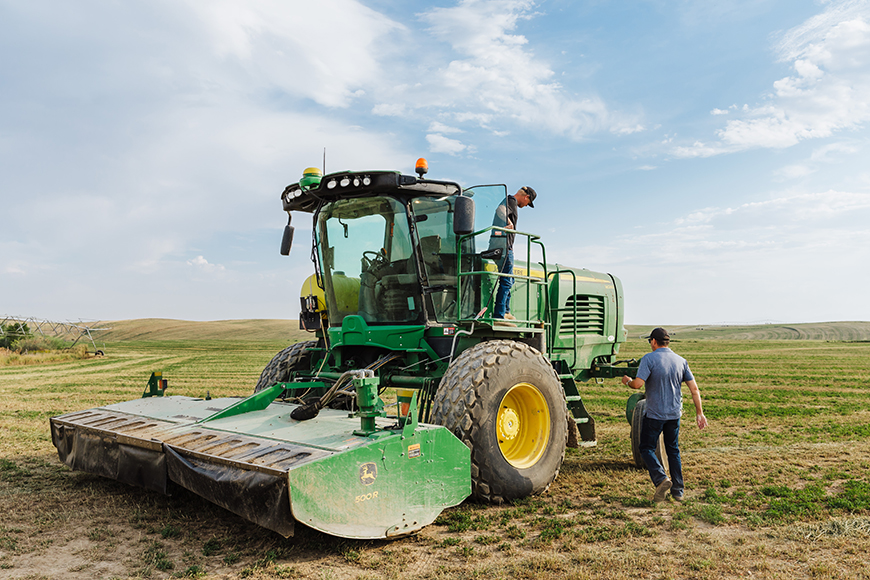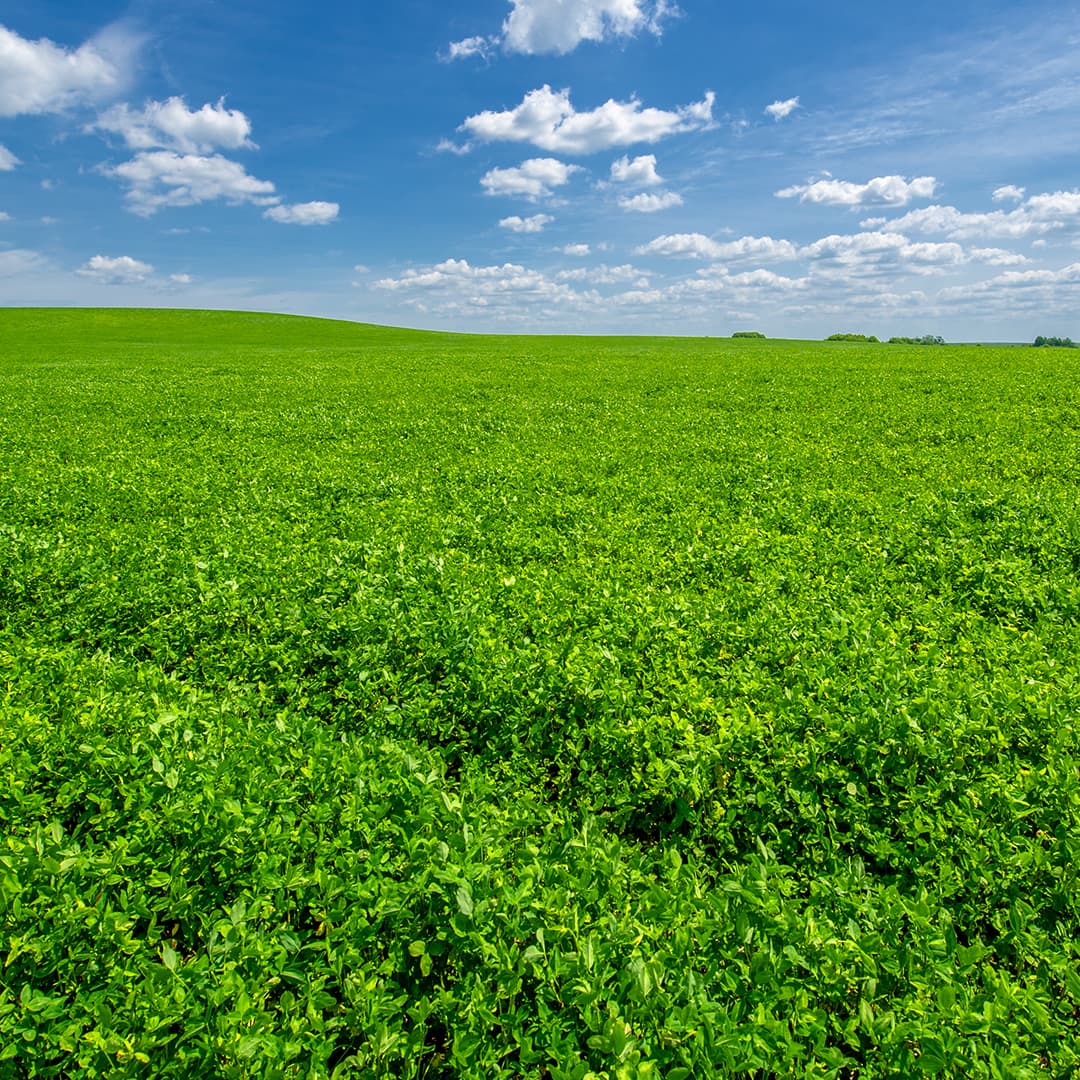Do you hook up the mower, grease it and head to the field? Taking the time to go over the mower and conditioner adjustments will greatly improve field performance. Follow these steps to do a quick, yet thorough maintenance check.
Inspect The Knives
First, look at the knives on a disk mower. How sharp are they? Rounded edges will strip the forage off, leaving rough edges while sharp knives will cut clean edges and require less horsepower.
Then, make sure you have the correct knives. Angled knives will pick up downed forage better while flat knives will pick up less dirt when the soil is dry.
Set Cutterbar Height
Next, set cutterbar height for the crop being harvested. For alfalfa, 3 inches is recommended. Cool-season grasses and alfalfa/grass mixtures should be cut at a 4-inch height, while sorghum and sudangrasses should be cut at 6 inches. Taller stubble height will reduce soil contamination, promote quicker drydown and allow better regrowth for the next crop.
Raised skids may need to be added to raise the cutting height in certain situations while maintaining the flat angle of the cutterbar. Cutting height may be adjusted manually or hydraulically with some machines, giving you the opportunity to change the cutting height from the cab.
Make Sure The Machine Is Level
Make sure your machine is level and the hitch height is correct, whether the mower has a drawbar, 2-point attachment or is fully mounted. This will allow the best ground following with effective suspension and proper ground pressure. Running the cutterbar as flat as possible reduces soil contamination of the crop. A steeper angle is more likely to draw dirt through the machine and deposit it into the crop. Greater cutterbar angle can also lead to a wavy cut and uneven stubble height.
Adjust Cutterbar Ground Pressure
Cutterbar ground pressure should be adjusted with both field conditions and ground speed in mind. It is best to start with light ground pressure to keep the cutterbar from plowing as it passes through the crop. In wet conditions, this is particularly important. If the cutterbar starts to float and skip with increased ground speed or rougher conditions, increase the ground pressure.
Consider A Roller Conditioner
A roller conditioner is recommended for alfalfa because flail or impeller machines developed for grasses tend to have greater leaf loss. Rubber and steel rolls result in similar drydown rates if properly adjusted, though rubber rollers wear and need to be replaced while steels rolls suffer more damage from stones. Rubber and steel rolls are usually intermeshing, so the ribs of the rolls make a crimp in the stem for faster drydown. The adjustments on these types of machines are roll gap and roll pressure.
Adjust Roll Gap
Adjust roll gap based on throughput and type of crop being conditioned. For example, you’ll want a wider gap for larger diameter stems. Narrow or widen the gap for differing volumes of crop as well as travel speed. Roll pressure goes hand-in-hand with roll gap. For alfalfa, roll gap clearance should generally be 1/16 inch. Check gap clearance by feeding a piece of 12x12 inch aluminum foil rolled into a tube through the conditioner. Separate aluminum tubes should be fed on each side of conditioner rolls to ensure spacing is consistent and in the middle to determine if the rolls have worn and need to be replaced. The conditioner rolls will crush the aluminum foil rolls and the minimum roll clearance can be determined. Measurement should be taken where the maximum crimp occurs.
Set Tension
Tension should be adjusted to cause crimping of the stems every 2 to 3 inches with 5% or less leaf bruising. More tension on the roll pressure adjustment leads to more aggressive conditioning of the crop. Less tension allows the rolls to open up easier for higher-yielding crops to flow through the machine with less conditioning. Tension may need to be loosened with less mature crops to prevent over conditioning.
Taking the time to make these equipment adjustments will help you achieve optimal conditioning and drydown time. Your local W-L Alfalfas® dealer can also help you double check your settings and make sure your harvest starts off smoothly.
© 2023 Forage Genetics International, LLC. W-L Alfalfas® is a registered trademark of Forage Genetics International, LLC. All other trademarks are property of their respective owners.
Inspect The Knives
First, look at the knives on a disk mower. How sharp are they? Rounded edges will strip the forage off, leaving rough edges while sharp knives will cut clean edges and require less horsepower.
Then, make sure you have the correct knives. Angled knives will pick up downed forage better while flat knives will pick up less dirt when the soil is dry.
Set Cutterbar Height
Next, set cutterbar height for the crop being harvested. For alfalfa, 3 inches is recommended. Cool-season grasses and alfalfa/grass mixtures should be cut at a 4-inch height, while sorghum and sudangrasses should be cut at 6 inches. Taller stubble height will reduce soil contamination, promote quicker drydown and allow better regrowth for the next crop.
Raised skids may need to be added to raise the cutting height in certain situations while maintaining the flat angle of the cutterbar. Cutting height may be adjusted manually or hydraulically with some machines, giving you the opportunity to change the cutting height from the cab.
Make Sure The Machine Is Level
Make sure your machine is level and the hitch height is correct, whether the mower has a drawbar, 2-point attachment or is fully mounted. This will allow the best ground following with effective suspension and proper ground pressure. Running the cutterbar as flat as possible reduces soil contamination of the crop. A steeper angle is more likely to draw dirt through the machine and deposit it into the crop. Greater cutterbar angle can also lead to a wavy cut and uneven stubble height.
Adjust Cutterbar Ground Pressure
Cutterbar ground pressure should be adjusted with both field conditions and ground speed in mind. It is best to start with light ground pressure to keep the cutterbar from plowing as it passes through the crop. In wet conditions, this is particularly important. If the cutterbar starts to float and skip with increased ground speed or rougher conditions, increase the ground pressure.
Consider A Roller Conditioner
A roller conditioner is recommended for alfalfa because flail or impeller machines developed for grasses tend to have greater leaf loss. Rubber and steel rolls result in similar drydown rates if properly adjusted, though rubber rollers wear and need to be replaced while steels rolls suffer more damage from stones. Rubber and steel rolls are usually intermeshing, so the ribs of the rolls make a crimp in the stem for faster drydown. The adjustments on these types of machines are roll gap and roll pressure.
Adjust Roll Gap
Adjust roll gap based on throughput and type of crop being conditioned. For example, you’ll want a wider gap for larger diameter stems. Narrow or widen the gap for differing volumes of crop as well as travel speed. Roll pressure goes hand-in-hand with roll gap. For alfalfa, roll gap clearance should generally be 1/16 inch. Check gap clearance by feeding a piece of 12x12 inch aluminum foil rolled into a tube through the conditioner. Separate aluminum tubes should be fed on each side of conditioner rolls to ensure spacing is consistent and in the middle to determine if the rolls have worn and need to be replaced. The conditioner rolls will crush the aluminum foil rolls and the minimum roll clearance can be determined. Measurement should be taken where the maximum crimp occurs.
Set Tension
Tension should be adjusted to cause crimping of the stems every 2 to 3 inches with 5% or less leaf bruising. More tension on the roll pressure adjustment leads to more aggressive conditioning of the crop. Less tension allows the rolls to open up easier for higher-yielding crops to flow through the machine with less conditioning. Tension may need to be loosened with less mature crops to prevent over conditioning.
Taking the time to make these equipment adjustments will help you achieve optimal conditioning and drydown time. Your local W-L Alfalfas® dealer can also help you double check your settings and make sure your harvest starts off smoothly.
© 2023 Forage Genetics International, LLC. W-L Alfalfas® is a registered trademark of Forage Genetics International, LLC. All other trademarks are property of their respective owners.


